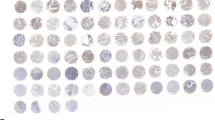Abstract
A large nuclear protein of 2089 amino acids, NFBD1/MDC1 has recently been implicated in tumorigenesis and tumor growth. In this study, we investigated its expression in cervical cancers and explored its function using gene knockdown approaches. We report here that NFBD1 expression is substantial increased in 24 of 39 cases (61.5%) of cervical cancer tissues at the mRNA level and in 35 of 60 cases (58.3%) at the protein level compared with the case matched normal tissues. Tumors with higher grade of malignancy tend to have higher levels of NFBD1 expression. By infecting cells with retroviruses expressing NFBD1 shRNA, we successfully knocked down NFBD1 expression in cervical cancer cell lines HeLa, SiHa, and CaSki. NFBD1 knockdown cells display significant growth inhibition, cell cycle arrest, higher apoptotic rate, and enhanced sensitivity to adriamycin. Furthermore, NFBD1 knockdown also inhibits the growth of HeLa cells in nude mice. Western blot analyses further revealed that NFBD1 knockdown induced Bax, Puma, and Noxa while down-regulating Bcl-2; it also up-regulated cytochrome C and activated caspases 3 and 9. Therefore, the function of NFBD1 may be involved in the CDC25C–CyclinB1/CDC2 pathway at the G2/M checkpoint, and the cytochrome C/caspase 3 apoptotic pathway. Since expression of NFBD1 seems to be related to the oncogenic potential of cervical cancer, and suppression of its expression can inhibit cancer cell growth both in vitro and in vivo, NFBD1 may be a potential therapeutic target in human cervical cancer.








Similar content being viewed by others
References
Dueñas-González A, Lizano M, Candelaria M, Cetina L, Arce C, Cervera E (2005) Epigenetics of cervical cancer. An overview and therapeutic perspectives. Mol Cancer 4:38
Yang Z, Bu Y, Wang C, Liu G, Song F (2010) Growth inhibition, morphology change, and cell cycle alterations in NFBD1-depleted human esophageal cancer cells. Mol Cell Biochem 342:1–6
Shang YL, Bodero AJ, Chen PL (2003) NFBD1, a novel nuclear protein with signature motifs of FHA and BRCT, and an internal 41-amino acid repeat sequence, is an early participant in DNA damage response. J Biol Chem 278:6323–6329
Stewart GS, Wang B, Bignell CR, Taylor AM, Elledge SJ (2003) MDC1 is a mediator of the mammalian DNA damage checkpoint. Nature 421:961–966
Bu Y, Suenaga Y, Ono S, Koda T, Song F, Nakagawara A, Ozaki T (2008) Sp1-mediated transcriptional regulation of NFBD1/MDC1 plays a critical role in DNA damage response pathway. Genes Cells 13:53–66
Ozaki T, Nagase T, Ichimiya S, Seki N, Ohiri M, Nomura N, Takada N, Sakiyama S, Weber BL, Nakagawara A (2000) NFBD1/KIAA0170 is a novel nuclear transcriptional transactivator with BRCT domain. DNA Cell Biol 19:475–485
Lou Z, Minter-Dykhouse K, Franco S, Gostissa M, Rivera MA, Celeste A, Manis JP, van Deursen J, Nussenzweig A, Paull TT, Alt FW, Chen J (2006) MDC1 maintains genomic stability by participating in the amplification of ATM-dependent DNA damage signals. Mol Cell 21:187–200
Yuan C, Wang C, Bu Y, Xiang T, Huang X, Wang Z, Yi F, Ren G, Liu G, Song F (2010) Antioxidative and immunoprotective effects of Pyracantha fortuneana (Maxim.) Li polysaccharides in mice. Immunol Lett 133:14–18
Ralhan R, Desouza LV, Matta A, Chandra Tripathi S, Ghanny S, Datta Gupta S, Bahadur S, Siu KW (2008) Discovery and verification of head-and-neck cancer biomarkers by differential protein expression analysis using iTRAQ labeling, multidimensional liquid chromatography, and tandem mass spectrometry. Mol Cell Proteomics 7:1162–1173
Takara K, Fujita M, Matsubara M, Minegaki T, Kitada N, Ohnishi N, Yokoyama T (2007) Effects of propolis extract on sensitivity to chemotherapeutic agents in HeLa and resistant sublines. Phytother Res 21:841–846
Tedesco D, Zhang J, Trinh L, Lalehzadeh G, Meisner R, Yamaguchi KD, Ruderman DL, Dinter H, Zajchowski DA (2007) The ubiquitin-conjugating enzyme E2-EPF is overexpressed in primary breast cancer and modulates sensitivity to topoisomerase II inhibition. Neoplasia 9:601–613
Ha SW, Kim YJ, Kim W, Lee CS (2009) Antitumor effects of camptothecin combined with conventional anticancer drugs on the cervical and uterine squamous cell carcinoma cell line SiHa. Korean J Physiol Pharmacol 13:115–121
Lee CS, Kim YJ, Lee MS, Han ES, Lee SJ (2008) 18 beta-Glycyrrhetinic acid induces apoptotic cell death in SiHa cells and exhibits a synergistic effect against antibiotic anti-cancer drug toxicity. Life Sci 83:481–489
Yeh PY, Chuang SE, Yeh KH, Song YC, Cheng AL (2003) Involvement of nuclear transcription factor-kappa B in low-dose doxorubicin-induced drug resistance of cervical carcinoma cells. Biochem Pharmacol 66:25–33
Bartek J, Lukas J (2007) DNA damage checkpoints: from initiation to recovery or adaptation. Curr Opin Cell Biol 19:238–245
Kastan MB, Bartek J (2004) Cell-cycle checkpoints and cancer. Nature 432:316–323
Bartkova J, Horejsí Z, Koed K, Krämer A, Tort F, Zieger K, Guldberg P, Sehested M, Nesland JM, Lukas C, Ørntoft T, Lukas J, Bartek J (2005) DNA damage response as a candidate anticancer barrier in early human tumorigenesis. Nature 434:864–870
Gorgoulis VG, Vassiliou LV, Karakaidos P, Zacharatos P, Kotsinas A, Liloglou T, Venere M, Ditullio RA Jr, Kastrinakis NG, Levy B, Kletsas D, Yoneta A, Herlyn M, Kittas C, Halazonetis TD (2005) Activation of the DNA damage checkpoint and genomic instability in human precancerous lesions. Nature 434:907–913
Fire A, Xu S, Montgomery MK, Kostas SA, Driver SE, Mello CC (1998) Potent and specific genetic interference by double-stranded RNA in Caenorhabditis elegans. Nature 391:806–811
Bartkova J, Horejsí Z, Sehested M, Nesland JM, Rajpert-De Meyts E, Skakkebaek NE, Stucki M, Jackson S, Lukas J, Bartek J (2007) DNA damage response mediators MDC1 and 53BP1: constitutive activation and aberrant loss in breast and lung cancer, but not in testicular germ cell tumours. Oncogene 26:7414–7422
Acknowledgments
This work was supported by grants from National Natural Science Foundation of China (No. 30872758, No. 30800410, and No. 30871237).
Conflict of interest
All the authors declare no conflicts of interest.
Author information
Authors and Affiliations
Corresponding author
Rights and permissions
About this article
Cite this article
Yuan, C., Bu, Y., Wang, C. et al. NFBD1/MDC1 is a protein of oncogenic potential in human cervical cancer. Mol Cell Biochem 359, 333–346 (2012). https://doi.org/10.1007/s11010-011-1027-7
Received:
Accepted:
Published:
Issue Date:
DOI: https://doi.org/10.1007/s11010-011-1027-7




